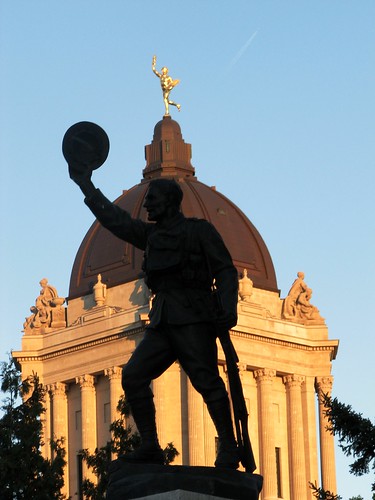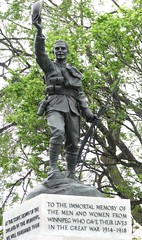Location: Broadway and Osborne, Legislature Grounds (Map)
Unveiled: May 13, 1923
Cost: $16,000
Artist: Marguerite Taylor
Background:
October 30, 1920, Winnipeg Tribune
Details were still to be worked out, but two things that they insisted upon were that it have a prominent place in the city, within 8 miles of Portage and Main, and that it include the name of every person from the Greater Winnipeg area who was killed in the First World War.
March 8, 1921. Winnipeg Free Press
The organization spent a year researching and compiling the names of war dead. This included a big public write-in campaign geared at local families. They also spent $1,000 to have researchers in Ottawa comb through death records to make sure that those without relatives in the city were not. The campaign wrapped up on November 1, 1921 with a two day phone-in blitz.
In the end, almost 1,600 names were collected. This number changed a couple of times after the initial figures were released, right up to year of the unveiling and one addition after the monument was erected. The final number appears to be 1,658.
Taylor. April 13, 1963, Winnipeg Free Press
As the names were being compiled there was, of course, the matter of the monument itself.Architect Colonel J. M Semmens of the 78th Battalion, Winnipeg Grenadiers was chosen for the design.
The artist chosen was Marguerite Taylor. Mrs Taylor was born, raised and trained in Paris as Marguerite Jud. She met and married husband Hilliard Taylor, a Canadian businessman based in London, and the couple settled in Winnipeg in 1904. Her sculptures can be seen all over the world, from Reykjavik to London and Philadelphia to Prince Albert, SK. Another local sculpture that may be familiar is the Peguis monument in Kildonan Park.
Taylor went to England for six months to work on the piece. She later told the Tribune about the inspiration for the figure:
“...the time peace was declared, when the victorious soldier threw his rifle into his left hand and triumphantly whirled his tin hat in the air. I wanted to do a happy soldier so the bereaved wives and mothers would not be too much saddened when they looked at it.” (source).
The
statue was cast by Burton and Co. of London in January 1923. The bronze tablets containing the names were
produced by Henry Birks and Sons in Montreal. The stonework was by Wyatt and Ireland of Winnipeg.
May 7, 1923, Winnipeg Tribune
The monument was unveiled on May 13, 1923, Decoration Day. That year's Decoration Day parade was said to have been the largest parade ever seen in Winnipeg and thousands jammed the Legislature grounds for the dedication.
Justice Dennistoun spoke of the importance of the monument:
"Whosoever in the future learns from this monument that 1619 men and women of this place sacrificed their lives in the late war will have cause for astonishment. That a comparatively small community in Canada, thousand of miles from the battle-grounds, should mourn 1619 dead, is in itself a fearful commentary on the hideousness of war, and a warning to those who come after to strive with all of their might for the avoidance of a like fate in future".
May 14, 1923, Winnipeg Free Press
May 14, 1923, Winnipeg Free Press
The cost of the monument was estimated at $25,000. It appears that much of the fundrasing went on behind the scenes, as there is little mention of it in the newspapers. Various service organizations, including the Kinsmen, raised money. The committee itself, which eventually numbered nearly 1,000, had a large contingent of local businessmen who, presumably, contributed and arm-twisted colleagues.
Ceremony. Winnipeg Tribune, May 18, 1942
This memorial was the setting for a Winnipeg Soldier's Relatives' Association ceremony each Decoration Day until the mid 1950s. The
ceremony usually consisted of a procession marching from All Saints
Church, a short eulogy, a song by the All Saints choir, taps and the
laying of flowers by relatives or for those who sent a flower to
Winnipeg to be laid.
It
was also the scene for many intimate commemoration ceremonies such as
family gatherings. On June 28, 1924 the nursing sisters held a memorial
to those killed on the hospital ship Llandovery Castle six years
earlier. On the morning of the start of the National Chapter of the
Daughters of the Empire conference in Winnipeg, a wreath was laid
before the meetings began.
The final Decoration Day Ceremony appears to have been held in 1956.
TO THE IMMORTAL MEMORY OF THE MEN AND WOMEN FROM WINNIPEG WHO GAVE THEIR LIVES IN THE GREAT WAR, 1914-1918. THEY DIED THE NOBLEST DEATH THAT MEN MAY DIE FIGHTING FOR GOD, TRUTH AND LIBERTY.
IN THE MORNING AND AT THE GOING DOWN OF THE SUN WE WILL REMEMBER THEM.
ERECTED BY THE LIVING HEARTS OF KINSMEN
Related:
Dedication Program Soldier's Relatives' Memorial Association
Next of Kin Monument Manitoba Historical SocietyList of all names that appear on the monument







No comments:
Post a Comment